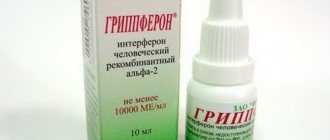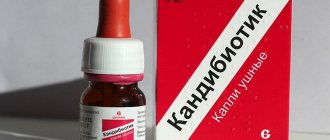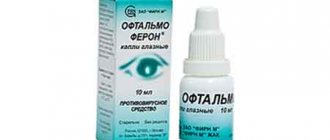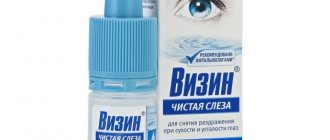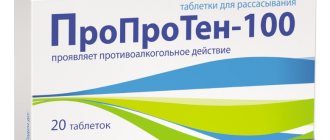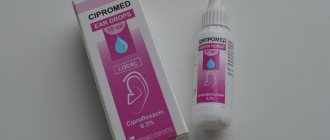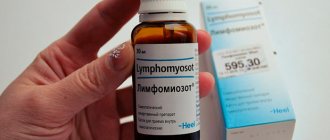Composition and release form
Parlazin drops are an almost transparent liquid, without impurities or sediment. The drug has a faint odor of acetic acid. The active chemical substance due to which the therapeutic effect of the drug is manifested is cetirizine dihydrochloride. Additionally, the liquid includes:
- glycerol;
- propylene glycol;
- sodium saccharinate;
- methyl parahydroxybenzoate;
- sodium acetate trihydrate;
- glacial acetic acid;
- purified water;
- propyl parahydroxybenzoate.
The medicine is released in brown glass bottles to protect it from light, which can destroy the components of the drops. The bottle is equipped with a dropper cap for ease of use and a child safety mechanism. The product is sealed in a cardboard package with an instruction insert. The volume of one bottle is 20 ml.
Indications for use of Parlazin
In accordance with the instructions for Parlazin and reviews of immunologists about it, this drug is indicated for the following diseases:
- Allergic rhinitis (runny nose) and conjunctivitis, which are both seasonal and everyday. Often these two pathological conditions go hand in hand, creating a “nuclear mixture” of symptoms, including difficulty breathing through the nose, copious discharge of mucus from the nose and tear fluid from the eyes, inflammation of the conjunctiva and unbearable itching;
- Hay fever, better known as hay fever;
- Urticaria, incl. unknown etiology;
- Skin allergic diseases, including diffuse neurodermatitis;
- Quincke's edema.
Pharmacodynamics, pharmacokinetics
The active substance is a carboxylated metabolite of hydroxyzine, belonging to the group of piperazine derivatives. The effect after using Parlazin drops is based on selective blocking of peripheral H1 histamine receptors. Due to this action, the drops inhibit allergic reactions and reduce the movement of cells involved in inflammatory processes. The drug reduces the production of mediators that are responsible for the manifestations of a late allergic reaction.
The medication has a mild antiserotonergic and anticholinergic effect.
After using Parlazin drops, its active chemical quickly penetrates the mucous membrane and enters the blood. Its maximum concentration in the liquid part of the blood is observed after 25-50 minutes. Eating does not affect the effectiveness of the medication, but can reduce the rate of absorption of the components, and the corresponding therapeutic effect occurs more slowly.
After entering the blood, the active substance binds to plasma proteins by approximately 94%. The drops do not have a cumulative effect, that is, the drug is completely eliminated from the body and is not addictive. Cetirizine penetrates the blood-brain barrier (into the brain) in extremely small quantities and passes freely into breast milk.
A smaller part of the substance is subject to metabolic processes, therefore cetirizine dihydrochloride is excreted mainly unchanged. During the first 24 hours, about 65% of the drug is excreted from the body through the kidneys and urine. About 10% is excreted through the intestines with feces. The rest of the drug is eliminated within 4 days. The rate of elimination of the drug may be reduced in case of kidney disease.
Read more Instructions for using Tobropt eye drops
pharmachologic effect
The fact that allergies are associated with inflammation has long been an open secret. But the mechanism of its development is not known to everyone. The inflammatory process develops under the strict guidance of special substances called inflammatory mediators, among which histamine occupies a prominent place. Histamine receptors are densely scattered in the organs and tissues of the human body. The role of Parlazin is to block these receptors, thereby preventing histamine from “igniting” inflammation to its fullest. The drug reduces blood flow to the site of inflammation, reduces swelling, prevents the development of skin manifestations of inflammation, relieves itching, and reduces smooth muscle tone.
Reviews of Parlazine note the early onset of its action: after 20 minutes, approximately half of the patients feel a pronounced therapeutic effect, and after an hour, almost everyone does.
Instructions for use
The antiallergic drug is intended for oral administration and can be diluted in a small amount of liquid before use. Dosage depends on age:
- Adults, adolescents under 12 years of age – 20 drops 1 time per day (preferably at night).
- From 6 to 12 years – 10 drops 2 times a day in the morning, evening or 20 drops before bed.
- From 2 to 6 years – 10 drops once a day or 2 times a day, 5 drops.
- From 1 to 2 years – 5 drops 2 times a day.
In case of severe kidney disease or old age, the dosage is selected by the doctor. The amount of the drug will depend on the degree of dysfunction of the organ. The duration of treatment is also determined by the doctor.
Parlazin Neo drops for oral administration 5mg/ml 20ml bottle No. 1
Parlazin Neo film-coated tablets 5 mg Parlazin Neo drops for oral administration 5 mg/ml
Qualitative and quantitative composition Each film-coated tablet contains 5 mg of levocetirizine dihydrochloride (corresponding to 4.21 mg of levocetirizine). 5 mg levocetirizine dihydrochloride in 1 ml drops for oral administration.
List of excipients Film-coated tablets: Core: microcrystalline silica cellulose (composition: microcrystalline cellulose, colloidal anhydrous silicon dioxide), lactose monohydrate (37.9 mg), low-substituted hydroxypropylcellulose (L-HPC-11), magnesium stearate. Shell: Opadry II 33G28523 white (composition: macrogol 3350, titanium dioxide (E 171), hypromellose 2910, lactose monohydrate (1.05 mg), triacetin). Drops: 85% glycerin, propylene glycol, sodium saccharinate, sodium acetate trihydrate, methyl parahydroxybenzoate, propyl parahydroxybenzoate, glacial acetic acid, purified water.
Dosage form Film-coated tablets White or almost white, round, moderately biconvex film-coated tablets, odorless or almost odorless. Engraving: on one side of the tablet there is a stylized letter E, on the other side there is the number 281. Drops for oral administration A colorless or almost colorless sweet liquid without sediment, with a faint odor of acetic acid.
Indications for use Symptomatic treatment of allergic rhinitis (including persistent allergic rhinitis) and chronic idiopathic urticaria.
Dosage and method of administration Film-coated tablets should be taken orally, swallowed whole with a small amount of water; they can be taken with or without food. It is recommended to take the daily dose at one time. The required number of drops should be measured using a dropper into a tablespoon or glass of water. Drops should be taken orally immediately after dilution, regardless of food intake. Adults and adolescents (ages 12 years and older) The daily recommended dose is 5 mg (1 film-coated tablet, 1 ml drops or 20 drops from an IV).
Elderly patients In elderly patients with moderate or severe renal impairment, dose adjustment is recommended (see section "Patients with renal impairment" below). Children aged 6-12 years The daily recommended dose is 5 mg (1 film-coated tablet, 1 ml drops or 20 drops from a dropper). Children aged 2-6 years The daily recommended dose is 2.5 mg in two doses in equal doses of 1.25 mg (2 times 0.25 ml drops = 2 × 5 drops from a dropper). This drug is not recommended for use in infants and children under 2 years of age due to insufficient data on drug administration (see section 4.4). Patients with impaired renal function The frequency of administration should be determined individually in accordance with renal function. Patients with impaired liver function When prescribing the drug to patients with isolated impaired liver function, no dose changes are required. For patients with concomitant impairment of liver and kidney function, dose adjustment is recommended (see section “Patients with impaired renal function” above).
Duration of taking the drug The duration of the course depends on the type, duration and course of symptoms. Treatment for hay fever requires 3-6 weeks, but for short-term exposure to pollen, one week of treatment is usually sufficient. Currently, there is clinical experience with the use of levocetirizine in film-coated tablets for 6 months. There is experience using the racemate for up to one year for chronic urticaria and chronic allergic rhinitis, as well as for up to 18 months for itching caused by atopic dermatitis.
Contraindications Allergy to levocetirizine, other piperazine derivatives or any of the auxiliary components of the drug. Contraindicated in patients with severe renal failure (creatinine clearance below 10 ml/min).
Special instructions and precautions for use Purpose of the drug Parlazin Neo film-coated tablets are not recommended for children under 6 years of age, since film-coated tablets do not allow the dose to be adjusted accordingly. Parlazin Neo drops are not recommended for use in children under 2 years of age due to insufficient data on the administration of the drug. Concomitant use of alcohol requires caution (see section 4.5). Parlazin Neo film-coated tablets contain lactose and should therefore not be prescribed to patients with rare hereditary galactose intolerance, hereditary Sami lactase deficiency or glucose-galactose malabsorption syndrome. Parlazin Neo drops can cause allergic reactions (sometimes late), as they contain methyl parahydroxybenzoate and propyl parahydroxybenzoate.
Interaction with other medicinal products and other types of interactions No studies have been conducted on the interactions of levocetirizine with other drugs (including CYP3A4 inducers). Interaction studies with the racemic substance cetirizine have shown no clinically significant adverse interactions (with pseudoephedrine, cimetidine, ketoconazole, erythromycin, azithromycin, glipizide and diazepam). A slight decrease in the clearance of cetirizine (16%) was observed after repeated administration of theophylline (400 mg once daily) and cetirizine at different doses. At the same time, the excretion of theophylline did not change with simultaneous administration of cetirizine. The extent of absorption of levocetirizine is not reduced in the presence of food, but the rate of absorption is reduced. Racemic cetirizine has not been shown to enhance the effects of alcohol, however, in sensitive patients, concomitant use of cetirizine or levocetirizine and alcohol or other CNS depressants may cause effects on the central nervous system.
Pregnancy and breastfeeding There are no data from clinical studies of levocetirizine during pregnancy. Animal studies have shown no direct or indirect harmful effects on pregnancy, embryonic or fetal development, childbirth or postnatal development. Caution should be exercised when prescribing this drug to pregnant women or nursing mothers.
Effect on the ability to drive a car and operate machinery Comparative clinical studies did not reveal signs of impairment in the level of wakefulness, reaction time or ability to operate vehicles after taking recommended doses of levocetirizine. However, some patients may experience drowsiness, fatigue, or asthenia while taking Parlazin Neo. Therefore, persons intending to drive a car, perform potentially hazardous activities, or operate machinery should consider their reaction to the drug.
Side effect The side effect frequency parameters used below are defined. as follows: Very common: >1/10; frequent: <1/10 and >1/100; uncommon: <1/100 and >1/1000; rare: <1/1000 and >1/10000; very rare: < 1/10000.
Immune system disorders Very rare: allergies, including anaphylaxis. Metabolism and nutrition Very rare: increased body weight. Mental disorders Frequent: drowsiness, increased fatigue. Nervous system dysfunction Common: headache, Uncommon: asthenia. Respiratory, thoracic and mediastinal dysfunctions Very rare: dyspnea. Gastrointestinal dysfunction Common: dry mouth. Uncommon: abdominal pain. Very rare: nausea. Disorders of the skin and subcutaneous tissues Very rare: angioedema, itching, skin rash, urticaria.
Examination results Very rare: abnormal liver function tests. Taking Parlazin Neo should be discontinued if any of the above effects reaches a clinically significant intensity, and its cause cannot be reliably determined.
Overdose Symptoms A significant overdose can lead to drowsiness in adults, and in children, first to agitation and anxiety, which are followed by drowsiness. Treatment There is no specific antidote for levocetirizine. In case of overdose, symptomatic and supportive treatment is recommended. A short period of time after taking the drug orally, you can perform a gastric lavage. Levocetirizine cannot be effectively removed by hemodialysis.
Pharmacological properties Pharmacodynamic properties Pharmacotherapeutic group: Antihistamines for systemic use, piperazine derivatives. ATX code: R06A E09 Levocetirizine, the (R) enantiomer of cetirizine, is a potent, selective peripheral H1 receptor antagonist. Binding studies have shown that levocetirizine has a high affinity for human H1 receptors (Ki = 3.2 nmol/l). The affinity of levocetirizine is 2 times higher than that of cetirizine (Ki = 6.3 nmol/l). Levocetirizine releases HI receptors with a half-life of 115-38 minutes. Pharmacodynamic studies in healthy volunteers showed that at half the dose, the activity of levocetirizine when applied to both the skin and mucous membrane is comparable to that of cetirizine. In vitro studies (Boyden chambers and cell layer method) have shown that levocetirizine inhibits eotaxin-induced transendothelial migration of eosinophils through skin and lung cells. In vivo pharmacodynamic experiments (skin chamber method) in 14 adult patients revealed that levocetirizine at a dose of 5 mg, compared with placebo, causes three main inhibitory effects during the first 6 hours of the response to pollen: suppression of the release of VCAM-1 (vascular endothelial adhesion molecule 1 - type), modulation of vascular permeability and reduction of eosinophilic infiltration. The efficacy and safety of levocetirizine have been demonstrated in several double-blind, placebo-controlled clinical trials in adult patients suffering from seasonal allergic rhinitis or perennial allergic rhinitis. In a 6-month clinical study of 551 adult patients (including 276 patients treated with levocetirizine) with persistent allergic rhinitis (symptoms on at least 4 days per week for at least 4 consecutive weeks) and sensitized to house mites dust and grass pollen, it was shown that levocetirizine at a dose of 5 mg had a clinically and statistically significant advantage compared with placebo in terms of the overall symptom score of allergic rhinitis throughout the study, without signs of tachyphylaxis. Throughout the study, levocetirizine significantly improved the quality of life of patients. Pharmacokinetic pharmacodynamic relationship: Levocetirizine at a dose of 5 mg gives the same pattern of inhibition of the inflammatory-exudative response to histamine as cetirizine at a dose of 10 mg. As with cetirizine, the effect of levocetirizine on histamine-induced skin reactions is out of phase with plasma concentrations. ECG did not reveal a significant effect of levocetirizine on the QT interval.
Pharmacokinetic properties The pharmacokinetics of levocetirizine is linear, independent of dose and time, and has small differences between subjects. The pharmacokinetic profiles of the single enantiomer and cetirizine are similar. No chiral inversion occurs during absorption or excretion. Absorption After oral administration, levocetirizine is rapidly and substantially absorbed. The maximum concentration in blood plasma is reached 0.9 hours after administration. The equilibrium state is reached after two days. Usual peak concentrations after single and multiple (5 mg daily) doses are 270 ng/ml and 308 ng/ml, respectively. The extent of absorption is dose dependent and independent of food, however, in the case of food intake, the peak concentration is reduced and occurs later. Distribution There are no data on the distribution of the drug in human tissues and penetration through the blood-brain barrier. In rats and dogs, the highest tissue levels are found in the liver and kidneys and the lowest in the central nervous system. Levocetirizine is 90% bound to plasma proteins. The distribution of levocetirizine is limited, since the volume of distribution is 0.4 l/kg. Biotransformation In humans, less than 14% of an administered dose of levocetirizine undergoes metabolic transformation, and differences due to genetic polymorphisms or concomitant use of enzyme inhibitors are considered to be minor. Metabolic pathways include oxidation of the aromatic ring, N- and O-dealkylation, and conjugation with taurine. Dealkylation is mainly mediated by CYP 3A4, and many and/or unidentified CYP isoforms are involved in the oxidation of the aromatic ring. Levocetirizine does not affect the activities of CYP isoenzymes 1A2, 2C9, 2C19, 2D6, 2E1 and ZA4 at concentrations significantly higher than the peak concentrations achievable after oral administration of 5 mg. Due to the low rate of metabolism and the absence of possible suppression of metabolism, interaction of levocetirizine with other substances is unlikely. Elimination The half-life from plasma is 7.9–1.9 hours. The average apparent clearance from the whole body is 0.63 ml/min per 1 kg. The main route of excretion of levocetirizine and its metabolites is through the kidneys in the urine; In this way, an average of 85.4% of the dose is eliminated. Excretion in feces is only 12.9% of the dose. Levocetirizine is excreted by both glomerular filtration and active tubular secretion. Impaired renal function The apparent clearance of levocetirizine from the whole body correlates with creatinine clearance. Therefore, it is recommended to adjust the intervals between doses of levocetirizine based on creatinine clearance in patients with moderate or severe renal impairment. In the anuric stage of renal disease, total body clearance is reduced by approximately 80% compared to healthy subjects. In a standard 4-hour hemodialysis procedure, less than 10% of levocetirizine is eliminated.
Preclinical Safety Studies Preclinical data indicate that this drug does not pose a significant risk to humans based on generally accepted safety, repeated dose toxicity, genotoxicity, carcinogenicity, and reproductive toxicity tests.
Shelf life: Film-coated tablets: 5 years Oral drops: 4 years
Storage conditions Film-coated tablets: store at a temperature not exceeding 30C. Drops for oral administration: store at a temperature not exceeding 25C. Do not freeze! Store an open bottle for no more than 6 weeks!
Type and contents of packaging Film-coated tablets: 7 or 10 film-coated tablets in a blister of combined cold film (polyamide/aluminum foil/PVC)/aluminum foil. 1, 2 or 3 blisters of 10 tablets, 1 or 2 blisters of 7 tablets are placed in a cardboard box with an instruction insert. Some package sizes may not be commercially available. Drops for oral administration Brown glass bottles with a thread for screwing on the cap, volume 20 ml, with a polyethylene dropper and a polypropylene cap with an internal polyethylene layer, equipped with special protection against opening by children and control of the first opening.
Reviews about use in children
Stefania, 27 years old, Moscow
I gave Parlazin drops to my little daughter when, at the age of 4, she had a severe allergy to strawberries. Most of the skin was covered with hives, the itching was very strong, my daughter constantly scratched her skin and could not sleep because of the itching. The pediatrician prescribed Parlazin. I gave her drops at night so she could sleep normally. The drug helped a lot, I noticed the effect on day 2, the child began to scratch the skin less. I only used it for a week and the hives went away.
Alena, 31 years old, Krasnodar
I bought Parlazin drops and was dissatisfied. At the age of 7, my son had allergic conjunctivitis. The doctor prescribed these drops. On the 2nd day after use, my son began to feel drowsy, although he did not exceed the dosage, he gave it as indicated in the instructions, and the doctor also prescribed it. We went for a second appointment, the pediatrician canceled the drug and prescribed another drug.
Reviews from doctors and patients
The drug is intended to eliminate allergic manifestations in adult patients and children. Tablets and drops are intended for this. They are convenient to dose, and administration does not require complex calculations. According to the responses of patients, the product quickly and effectively eliminates swelling, lacrimation and skin reactions. The itching is eliminated, the runny nose goes away, and the condition quickly improves.
Sometimes doctors prescribe Parlazin for allergies to children before vaccination. Reviews from experts show that this practice is justified if the baby has previously experienced adverse events due to vaccination. However, the drug should not be prescribed to everyone because of the risk of latent allergies.
Parents of children aged one year and older noted the effectiveness and safety of the drug. It does not cause drowsiness, so schoolchildren can use it without consequences. However, the tablet form sometimes provokes some lethargy in adolescents and elderly patients.
Side effects are rarely detected. Usually the drug is well tolerated, but as a monotherapy it does not always successfully cope with hay fever. During flowering of plants, it is important to prescribe other medications to the patient, otherwise phenomena such as dizziness or drowsiness may worsen.
Side effects
The antiallergic solution is most often well tolerated by the body, but side effects from various organs and systems are still possible. From the nervous system:
- headache;
- dizziness;
- excitation;
- drowsiness;
- confusion;
- depression;
- insomnia;
- dystonia;
- decreased or increased skin sensitivity;
- fainting;
- nervous tic;
- trembling of limbs.
On the part of visual function, disturbances of accommodation and nystagmus may occur. In a biochemical analysis, while taking the drug, the number of platelets may decrease. Side effects from the digestive system:
- nausea;
- vomit;
- abdominal pain or discomfort;
- stool disorder;
- disruption of the functioning of liver cells may be manifested by changes in the level of liver transaminases, alkaline phosphatase, and bilirubin.
Read more Mastodinon drops - how to use for mastopathy
Rhinitis, pharyngitis, tachycardia, urinary incontinence, and urinary disorder are also possible. An allergic reaction can manifest itself as a skin rash, itching, urticaria, and extremely rarely, angioedema.
Negative consequences
Reviews from patients and doctors show that the drug is usually well tolerated. Both adults and children do not demonstrate sharp negative reactions. However, Parlazin can theoretically cause side effects.
The instructions for use contain all the necessary information about this:
- from the respiratory system - rhinitis, pharyngitis;
- on the part of the hematopoietic system - changes in the direction of imbalance;
- from the nervous system - aggression, drowsiness, insomnia, headache, convulsions, confusion, tremors of the limbs, depression, hallucinations;
- from the organs of vision - impaired visual perception;
- from the urinary system - urinary incontinence;
- from the digestive system - diarrhea, dry mucous membranes, stomach pain;
- itching, skin rash and swelling.
If your condition worsens, you should stop taking it and see a specialist.
Use during lactation, pregnancy
The active substance passes freely into breast milk, and with it into the baby’s body. Therefore, you cannot use antiallergic drops while breastfeeding. If it is necessary to use the drug and it is not possible to replace it with another drug, it is worth weaning the baby from the breast for the duration of treatment and switching to artificial feeding. To prevent breast milk from disappearing at this time, it must be expressed several times a day, approximately at the time when the baby drank it.
Produce indicates that clinical studies on the safety of the drug in pregnant women have not been conducted and how it affects the mother and fetus is unknown. Therefore, pregnancy is a contraindication to the use of the product.
special instructions
If negative symptoms or an allergic reaction appear, use should be discontinued. In case of severe kidney pathologies, it is necessary to adjust the dosage. If left unadjusted, cetirizine excretion may be reduced, increasing the likelihood of side effects. In addition, an increase in the severity of the disease, impaired renal function, and the appearance of an anticholinergic effect are possible.
Elderly people sensitive to the anticholinergic effect may experience dry mouth and urinary problems. If these symptoms do not disappear within 2 days, you should stop taking the drug or reduce the dosage. The liquid contains methyl parahydroxybenzoate, which sometimes causes late allergic reactions (after 3-4 days). While taking Parlazin drops, it is not recommended to drive or do work that requires concentration, as psychomotor reactions may slow down.
Other Cautions
Older patients are more prone to side effects. Constant monitoring of such patients is important.
If you are planning to test for allergens, then you should temporarily stop taking the medication, because the active ingredient may distort the results obtained.
Due to the fact that the drug can cause drowsiness and inhibition of reactions, it is better to refrain from driving a car or working on complex mechanisms.
It is worth remembering that the pills contain lactose. Therefore, those diagnosed with lactose intolerance need to take the medicine in the form of drops. A disturbance in the metabolism of carbohydrates is also a reason to switch to drops.
Overdose
If you systematically exceed the number of drops per dose or drink them more often than indicated in the instructions, symptoms of overdose may occur. Their severity depends on the degree of excess dosage. The most pronounced effects are observed after accidentally drinking the entire bottle of drops, which most often affects children if the drug was stored in a place accessible to them. Overdose symptoms:
- drowsiness;
- dry mouth;
- state of stupor;
- urinary retention;
- irritability;
- constipation;
- anxiety.
If you consume a large amount of the product, you must induce vomiting and take sorbents (Polysorb, activated carbon, etc.). Next, depending on the severity of the symptoms, call an ambulance or consult a doctor yourself for symptomatic treatment. There is no specific antidote to cetirizine dihydrochloride. Hemodialysis is not carried out in case of overdose; in this case it is not effective.
Read more Drops Hofitol for children and adults - instructions and analogues
When is it indicated?
Parlazin can be recommended for children and adults.
Instructions for use contain the following information:
- the medicine is prescribed by a doctor in case of an allergic reaction to eliminate it;
- suitable as a complex treatment for other diseases accompanied by swelling of the nose, itching of the skin and lacrimation;
- used for symptomatic and etiological therapy.
As for children, the drug "Parlazin" is used in pediatrics mainly to relieve symptoms of allergic manifestations, the cause may be:
- hay fever;
- hives;
- contact allergy;
- other states of hypersensitivity.
However, the drug can also be used in the treatment of children and in other areas of medicine. For example, in pulmonology and dermatology, the drug is widely used. It perfectly relieves swelling and itching, so it is also used during the treatment of acute respiratory infections.
Drug interactions
With parallel administration of Theophylline over 450 mg per day, the total clearance of the active substance of the drops decreases, the pharmacokinetics and pharmacodynamics of Theophylline do not change. Studies have not revealed any negative interactions with the following drugs:
- Diazepam;
- Azithromycin;
- Erythromycin;
- Cimetidine;
- Pseudoephedrine;
- Ketoconazole.
In a study on the combined use of drops and antibiotics from the macrolide group, no negative effects on the body were noted. When treating with any antihistamines, including Parlazin, it is not recommended to drink alcohol, so as not to cause side effects and reduce the effectiveness of the drops.
Concomitant use with other medications
The drug can be combined with other drugs, but the following information must be taken into account:
- if simultaneous treatment with macrolide antibiotics and cetirizine-based drugs occurs, then there should be no changes in the cardiogram;
- taking Parlazin is compatible with treatment with erythromycin;
- During treatment with Parlazin, you should avoid ethanol-based medications, as well as any alcoholic beverages;
- co-administration with theophylline leads to a decrease in the effect of cetirizine.
There are also other special instructions that are stated in the annotation. So, if individual intolerance or any unwanted side effects are detected, it is important to stop taking it and consult a doctor.
Patients with renal impairment deserve special attention. The fact is that the active substance in this case is excreted much more slowly, and its accumulation in the body provokes negative consequences. The doctor usually selects an individual dosage for such patients.
Storage conditions, expiration date, release from pharmacies
The antiallergic agent is stored away from sunlight and children at a temperature not exceeding 25°C. After use, be sure to close the bottle cap until it clicks so that children cannot open the product. The shelf life of the medicinal properties is 4 years from the date of release indicated on the package. After opening the drug, it can be used for 1 month. Parlazin drops are dispensed from pharmacies without a doctor's prescription.
The average cost of Parlazin drops in a volume of 20 ml is 265 rubles. The price depends on the region of residence and the pharmacy network. When ordering through online pharmacies, the cost will be lower.
Analogs
Parlazin drops have many analogues, so if necessary, they can be replaced with products similar in action or composition:
- Loratadine;
- Cetrin;
- Aleron;
- Claritin;
- Zodak;
- Erius;
- Fenistil;
- Desal.
These drugs can be replaced with Parlazin only after consultation with a doctor, since all of them have contraindications for use.
What is possible to replace
There are a lot of allergy remedies available in pharmacies. The differences are in the main active ingredient and the presence of side effects. Of course, it is recommended to select an analogue together with a doctor, but the most popular drugs can be identified:
- Based on cetirizine - Indian remedy "Cetrin". You can also purchase it in tablet form. Syrup is available for children.
- Cetirizine is also contained in the Polish drug Allertek.
- Levocetirizine, a derivative of cetirizine, is contained in Aleron.
- "Suprastin" is a popular drug that has a fairly strong effect. But it has one drawback - a strong sedative effect.
- Fenkarol also affects the ability to control mechanisms, but patients note its rapid action. However, this is not the latest generation drug.
In any case, it is better to make the final choice together with your doctor, because “Parlazin” analogues are completely different, and not all of them contain cetirizine as the main component.
